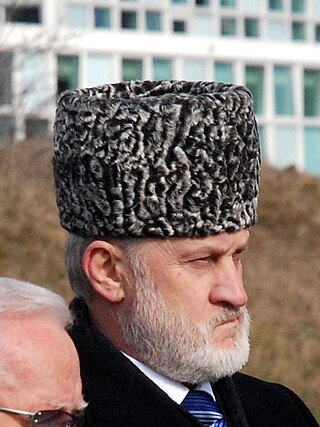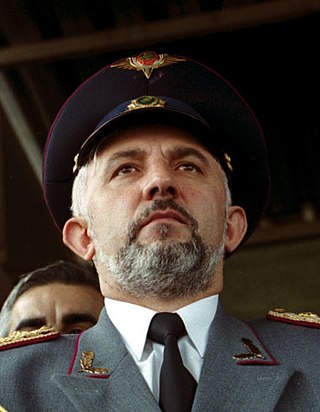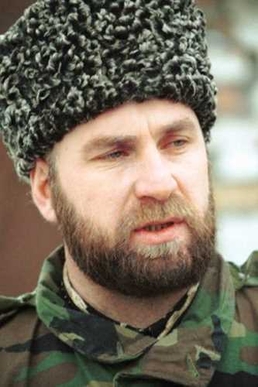Battle
On August 6, 1996, Chechen units attacking Grozny consisted of around 1,500 fighters. Initially, Russian media reported that only 250 fighters had entered the city. The Russian garrison inside the city consisted of some 12,000 troops. To overcome the Russian numerical superiority, Chechen chief of staff Aslan Maskhadov employed infiltration tactics. Using their intimate knowledge of the city, Chechen units entered Grozny and avoided the network of Russian checkpoints and other positions in a carefully planned and highly coordinated rapid advance before attacking or blocking targets deep in Moscow-controlled territory.
Their main objectives were the command and control assets at the military airfield at Khankala and the militarised Severny Airport (Grozny Airport), along with the headquarters of the FSB and GRU security and military intelligence services. They also blocked roads and took up strategic positions on the approaches to the city. According to Chechen commander Turpal Ali-Kaimov, 1,500 Chechen fighters infiltrated the city, of which 47 were killed during the initial attack.
The Chechen forces attacked Grozny at 5:50 on August 6 in an operation that took three hours. Rather than trying to capture or destroy all individual fortified checkpoints (blokpost), barracks, police stations, and other Russian positions, the Chechen fighters cut off and isolated most of them, mining the approaches to prevent escape or reinforcements, and waited for the government troops to surrender. By August 9, Russian news agency Interfax put the number of surrounded troops at some 7,000. In addition to MVD and FSB troops and non-combat personnel, military troops were stationed in the city.
The largest pocket was located at the government offices in the center of the city, including the interior ministry building and the republican FSB headquarters. A group of about 10 Russian journalists were trapped in a hotel near the compound. The pro-Russian Chechen government fled to Khankala military base, just outside the capital. In another part of the city, several groups of Russian troops took shelter at the Municipal Hospital 9, where they held approximately 500 civilians hostage until they were allowed to evacuate.
A number of Chechens deemed to be collaborators were rounded up, detained, and executed. According to the human rights organization Memorial, reliable sources stated that the execution list for one region of Grozny comprised more than 200 names. Said-Magomed Kakiyev was the only survivor of a group of 30 Chechen OMON special police officers who were executed by the fighters of Dokka Umarov and Ruslan Gelayev after defenders at the mayor's office surrendered on August 6, reportedly on the promise of free passage. [16]
According to Gelayev, "Zavgayev had either 15 or 18 thousand 'Chechen policemen' [in all of Chechnya], but as soon as we entered Grozny in August 1996, they all scattered and went home, then they went over to the Mujahideen, except for a few dozens of those who were guilty of shedding Chechen blood." [17] Within a week, the number of Chechen fighters in Grozny grew to between 6,000 and 7,000 as members of Zavgayev's forces changed sides and reinforcements were received.
On August 7, a large armored column from the 205th "Cossack" Separate Motor Rifle Brigade arrived to assist the trapped Russian forces. The day before, a Chechen separatist group led by Akhmed Zakayev had captured a large supply of RPO rocket launchers by seizing Grozny's main railway station (according to the 2002 indictment by the Russian government, Zakayev's fighters killed or wounded more than 300 MVD troops at the train station); as a result, Russian tanks became much easier targets for Chechen mobile units.
When the Russian military sent another column on August 8, they too were stopped and lost many vehicles to Chechen ambushes. On the fifth day of the battle, 900 fresh soldiers of the 276th Motor Rifle Regiment attempted to retake the center of the city, but failed at the price of about half of them being killed or wounded within just two days. Only one column of armored vehicles succeeded in delivering some supplies to the besieged federal stronghold in the city center and evacuating some of the wounded. Over the course of five days of counterattacking, Russian columns lost 18 tanks, 69 other armoured vehicles, and 23 trucks and cars. In addition, four helicopters were shot down.
The head of the International Red Cross in Grozny said that "most of the city is mined, and there's a lot of aerial bombardments." The European Union called on both sides to cease fire immediately, without effect. Russian President Boris Yeltsin declared a day of mourning for the victims in Chechnya. Battles also continued on the outskirts of the city and elsewhere in the republic.
On August 19, Russian General Kostantin Pulikovsky surrounded the city and issued an ultimatum that the Chechen fighters should leave Grozny within 48 hours or face an all-out attack. The threat resulted in mass panic among the remaining civilian population, estimated by Human Rights Watch at 300,000. Strikes by aircraft and artillery commenced on August 20. In chaotic scenes, as the bombardment indiscriminately hit residential areas and at least one hospital, terrified refugees fled the city. Many of them were reportedly killed when their columns were hit by artillery fire. In all, about 220,000 refugees fled the city.
The number of those who remained in the city was estimated by Memorial at between 50,000 and 70,000, and males older than 11 were considered suspected fighters and not let through the Russian lines. Many refugees were also fired on at checkpoints, and Russian state television ORT journalist Ramzan Khadzhiev was shot dead by federal soldiers while trying to flee the city. Russian General Alexander Lebed managed to mostly avert further bloodshed in Grozny. Meanwhile, the Russian offensive in the southern mountains continued.
After returning to Chechnya on August 20, Lebed ordered a new ceasefire and re-opened direct talks with the Chechen leaders, aided by the Organization for Security and Co-operation in Europe (OSCE). On August 22, Russia agreed to withdraw of all its forces in Chechnya to their bases at Khankala and Severny. On August 30, 1996, Generals Lebed and Maskhadov signed the Khasav-Yurt Accord, an agreement that marked the end of the First Chechen War.











